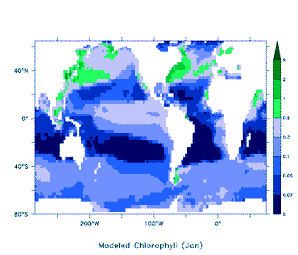Simplified ocean biogeochemistry model (BLING)
A simplified model of biogeochemical cycling- entitled Biology Light Iron Nutrient and Gas model (BLING) has been developed as a result of a collaboration between Anand Gnanadesikan (Oceans and Climate Group), Eric Galbraith and Mike Hiscock (AOS Program) and John Dunne (Climate and Ecosystems Group) based on extensive collaborations over the years with Jorge Sarmiento’s group.
For many years, biogeochemical models have explicitly modeled nutrients (N), floating marine plants (phytoplankton, P), zooplankton (Z) and detritus/dissolved organic matter (D), leading to the title NPZD models. Such models have strong dependencies on poorly known zooplankton physiology and require setting many constants. Our idea was to develop a simpler model based on paramet erizing the biological cycles. Our goals were to:
erizing the biological cycles. Our goals were to:
- Make the basic driving reflect the mechanisms known to affect phytoplankton growth (temperature, macronutrients such as phosphate and micronutrients such as iron, and light). We based this component on the work of Richard Geider, particularly this paper.
- Make the grazing rate produce recycling of organic matter and biomass consistent with what we know (low growth rates give high recycling, high growth rates give less recycling. We based this on a synthesis published by Dunne and coauthors in 2005.
The model set up to mimic the more complicated TOPAZ (Tracers in the Ocean with Allometric Zooplankton) model whose development is headed by John Dunne. The purpose of BLING is to allow cheap runs in much higher-resolution simulations and to serve as a testbed for alternative formulations of key biogeochemical processes.
Results of a preliminary version of this model are shown in the movie at right.
Documentation
- Map of the BLING model
- Galbraith, Gnanadesikan, Dunne and Hiscock, Regional impacts of iron-light co-limitation on global biogeochemical cycling, Biogeosciences Discussions, 6, 7517-7564, 2009. Link
Work in progress
Gnanadesikan, Galbraith, Hiscock and Dunne, Phytoplankton physiology, iron limitation and the deep chlorophyll maximum, in prep. for Biogeosciences.


